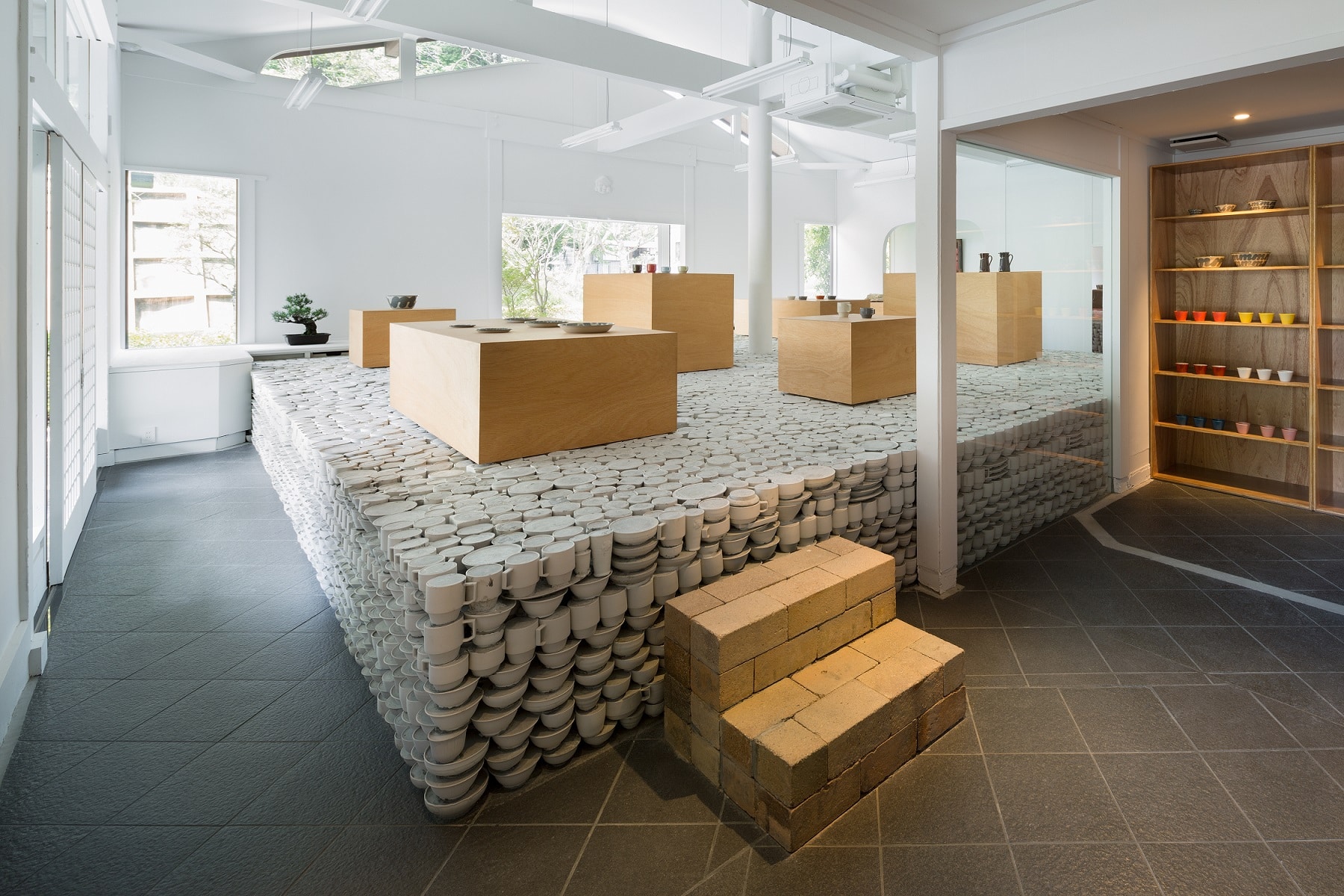Top designers around the world are playing with ceramics, from the eccentric to the everyday. In parallel to those such as Jamie Hayon, NENDO, Moooi and Marcel Wanders and more; ArchiExpo identifies one of many key design specialties in Mexico, the United States, Canada, England, Japan, Australia, Russia and South Africa. Check it out.
USA: Aandersson Ceramics
Philadelphia-based ceramic design studio Aandersson explores the limitations of ceramics materials through forms.
“Porcelain is known to be a material that warps and bends as it is being used and fired, so I try to find really unstable forms to cast with porcelain and find ways to formulate the material where it can be used in a non-traditional context,” Ian Anderson told ArchiExpo e-Magazine.
“Sometimes I run into a problem where I can’t compromise the form’s dimensions, so I have to use a different material like glass or metal.”
Looking to the sky, Anderson admits the next thing on his agenda with ceramics could be anything. “I really like using materials that have a very specific historical, cultural relevance.”
“Terracotta is one example of a referential material and I only started to explore how that can be used in a more modern context, so I would like to continue doing that.”

Courtesy of Aandersson ceramics
England: Layer Design (Benjamin Hubert)

Seams by Benjamin Hubert. Courtesy of Layer Design
“We’ve been working with Italian ceramics manufacturer Bitossi for the last few years and we just launched a new collection with them,” Benjamin Hubert, founder of and designer at Layer Design, said in a phone interview with ArchiExpo.
Hubert explains his Canisters and Seams collections.
“The first two collections were around the molding technologies. Slip-cast molds that you conventionally produce ceramics from, but rather than cleaning up the mold details and removing them, we celebrate them. It’s about transparency and showing how things are made. The parting lines from the mold are retained on the pieces.”
Into the future with Hubert: “I really like industrial ceramics. The kind of ceramics used in medical products and sometimes used in timepieces and watches. They’re really hard and really durable and have great heat properties. It’s a special material, and is quite expensive. I’d like to explore that.”
“I’d like to use ceramics on something much more necessary than just a piece of decoration.”
Japan: Maruhiro Flagship store
Less than a year ago, in April 2015, Tokyo-based designer Yusuke Seki renovated the pre-existing Maruhiro Flagship store. He put together a stacked central platform with 25,000 pieces, in cooperation with numerous pottery factories from the renowned ceramics region Hasami, Nagasaki Prefecture.
Maruhiro, a leading Hasami Porcelain client, welcomed these 25,000 revived shinikiji pieces, clay products whose ‘state of being’ is no longer useful. They were originally flawed after the initial bisque firing by their respective local production facilities. Seki used them to make bricks and transformed them into a new architectural material.
The platform represents monohara, the name given to the kiln-side specific areas where broken pieces from the firing process are disposed–existing solely in Nagasaki. Broken pieces in monohara, an archaeological dream, have been growing into beautifully imperfect pieces for approximately 400 years.
Yusuke Seki’s new project Tadafusa- Knife factory store will be coming up shortly so stay tuned.

A stacked central platform with 25,000 pieces by Yusuke Seki. Courtesy of Maruhiro Flagship store. Photo credit Takumi Ota
Canada: Karl Stittgen & Norko Sasaki
“Our ceramics are made of stoneware and individually formed by hand. Any imperfections are the result of the working process or are intentional to create a sense of Thusness or Wabi Sabi, the beauty of imperfection,” artists Karl Stittgen & Nora Sasaki at Ceramics Studio & Gallery explain on their website.
This Canadian husband and wife duo live on their Pender Island oasis surrounded by uncontrolled landscape, elements that pour into their rich source of artistic inspiration. Stittgen is known for tree bark, lichen, seafoam and other natural elements incorporated into his pieces.
“That sort of goes together with the roughness of the texture of the pottery,” Stittgen said in an interview with North Shore News in October, 2015.
Stittgen, a well-known name in the jewelry business, opened Creative Hands in West Vancouver in 1954. Following the Japanese wabi-sabi esthetic: He created thirty hand-crafted stoneware vessels that were shown during the Song of the Earth exhibit at the Ferry Building Gallery last year.
Australia: Ceramic Riders
This video shows the device that Ion Fukazawa made to create centrifugal force via a manned-bicycle for producing ceramic objects. This represents Ion Fukazawa’s final year design exhibition for the College of Fine Arts, Australia [CoFA Art Design Media]. The film was shot using a Sony FS700 with Zeiss primes at Cockatoo Island in Sydney.
Russia: Lera Moiseeva
Lera Moiseeva, originally from Tarusa, Russia, has worked with designers such as Luca Nichetto. Together with Nichetto in 2014, she created a ceramic tableware collection to accompany a porcelain coffee set, for an exhibition at Spazio Rossana Orlandi.
Her porcelain collection featured in this issue shows her expressive, experimental personality. She grew up in a family of space engineers and became fascinated with images of the universe. It’s no wonder her design aesthetics appear influenced by images of the space industry. In addition to porcelain, she enjoys working with glass and wood.
To end the year well, she earned the Wallpaper* Award for Best Coffee 2015 (SUCABARUCA for Mjölk).
A bit of background: She obtained her degree in sociology in Moscow, after which she also received her degree in product design from IED Madrid.
South Africa: Imiso Ceramics
Watch the video to see how ceramics are worked in Cape Town. Jump directly into the design-on-ceramics part of the video by skipping to 1:30.
Zizipho Poswa, the co-founder of Imiso Ceramics, designs and creates the brand’s popular Hand-Pinched Ceramic collection. She translates textile designs onto her clay canvas of decorative bowls and plates. Her pieces have been showcased in boutiques around the world.
Before co-founding the company with Poswa, Majolandile Dyalvane was employed at the Potter’s Shop and Studio, painting ceramics. His work became recognized and he received a scholarship to further his career in ceramic design.

Blue Serpentine Vase by Abel Zavala. Courtesy of Angulo Cero
Mexico: Blue Serpentine Vase
Blue Serpentine Vase is a creation by artist and ceramist Abel Zavala, born in Xalapa, Veracruz. Using various techniques such as painting, ceramics and embroidery with animal hair, he follows a line based on a minimalist aesthetic. This simplicity can be seen in his Serpentine Vase.
The consistency in his work stems from a deep interest in formal quality and close attention to details. His work has been exhibited in Mexico, Canada, Belgium, England, United States and Japan. He is one of the listed creators at Ángulo Cero, a platform that offers a new way to discover, acquire and learn about emerging collectible design and art from Latin America.
Commissioning limited editions and unique pieces that promote the intersection between art and design, and throughout a showroom and the Collectors Shop, Ángulo Cero combines a new commercial concept with editorial content to connect and inspire great talents, audiences and markets.












